the magazine for gardening enthusiasts in the Mid-Atlantic region


the magazine for gardening enthusiasts in the Mid-Atlantic region

No Need to Be Nervous about Ner ve Plants
Planting Alliums for Beauty
Plant Broccoli in Spring or Fall
Great Gardening Books Reviewed Are Inoculated Seeds Safe for My Garden? 12 Kinds of Daffodils to Plant for Spring Bloom
The Elm Zigzag Sawfly is Here!
The Red-bellied Woodpec ker
Michelle Nelson, Community Garden Program Manager


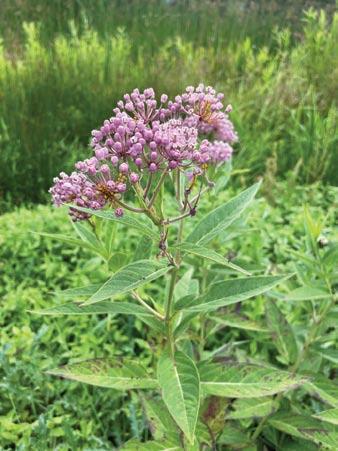


Washington Gardener Magazine’s staff and writers are available to speak to groups and garden clubs in the DC region and ONLINE! Call 240.603.1461 or email KathyJentz@gmail.com for available dates, rates, and topics.
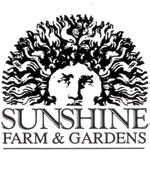
RARE AND EXCEPTIONAL PLANTS FOR THE
Barry Glick
Sunshine Farm and Gardens
696 Glicks Road
Renick, WV 24966, USA Email: barry@sunfarm.com www.sunfarm.com
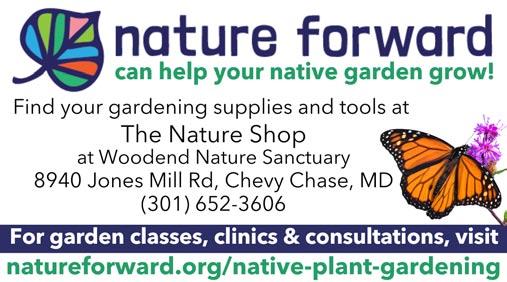

www.greenspring.org
Are you trying to reach thousands of gardeners in the greater DC region/Mid-Atlantic area? Washington Gardener Magazine goes out on the 15th of every month. Contact KathyJentz@gmail.com or call 301.588-6894 for ad rates (starting from $200). The ad deadline is the 10th of each month. Please submit your ad directly to: KathyJentz@gmail.com.
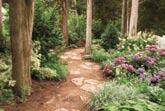
A “must visit” for everyone in the metropolitan Washington, DC, area. It’s a year-round goldmine of information and inspiration for the home gardener. It’s an outdoor classroom for children and their families to learn about plants and wildlife. It’s also a museum, a national historic site that offers glimpses into a long, rich history with colonial origins. Located at 4603 Green Spring Rd., Alexandria, VA. Information: 703-642-5173.
A brilliant cloud-lit sky highlights the George Washington and Jefferson National Forest in fall. Photo courtesy of USDA Forest Service.

Send your questions to KathyJentz@gmail.com and use the subject line “Q&A.” Then look for your answered questions in
Some states prohibit the growing of non-commercial cotton. In Virginia, the grower must apply for and receive an exemption.
To request an exemption for the production of noncommercial cotton, fill out an online “Request to Grow Cotton” form and email the completed form to David. Gianino@vdacs.virginia.gov.
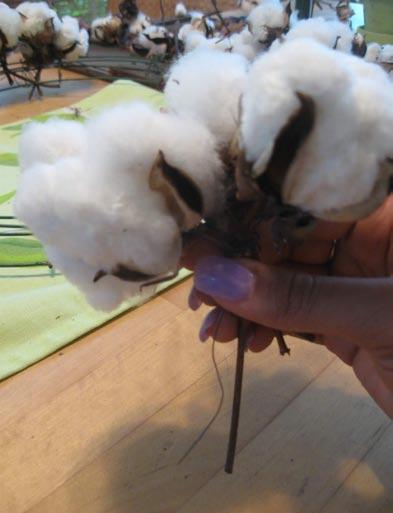
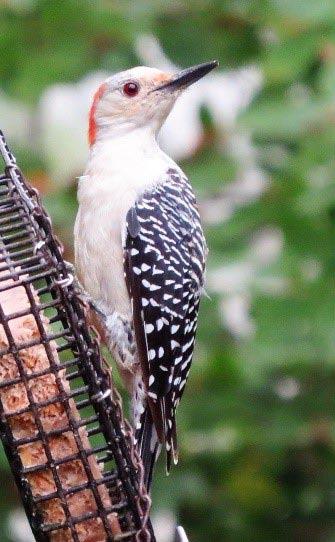
Red-bellied Woodpeckers, like this female, come readily to backyard bird-feeders featuring suet or peanuts. They have even been spotted drinking nectar from hummingbird feeders. Photo by Cecily Nabors.

Fall is for planting, and that includes trees. I have one large Oak tree that is declining in health rapidly and will be removing it soon. I now have the opportunity to plant something else in its place. A Sugar Maple keeps trying to come up next to it, and I may just take the easy way out and let that happen.
While I finish this issue, we attended the 13th annual Urban Tree Summit. As media sponsors, we are pleased to support arborists and urban foresters in their efforts to save our current tree canopy and replenish lost trees with new saplings. (More about what we learned at that event in our next issue.)
Fall is also time to for local trips to see the leaf color changes in the Shenandoah Valley and other popular leaf-viewing spots. Due to the drought this summer, I fear our color ranges may be light-brown and dark-brown, but I hold out some hope that recent rains will bring a brighter showing.
Finally, fall is for reflecting on the growing season and what went right and wrong this past year. It is time to assess where you want to expand new plantings and plan for renewal of old beds. It is also a great time to take advantage of end-ofseason sales at our local independent garden centers to buy a few things to replace what we have lost this year.
Sincerely,

Kathy Jentz, Editor/Publisher, Washington Gardener, KathyJentz@gmail.com
Kathy
Jentz Editor/Publisher
Washington Gardener
826 Philadelphia Ave. Silver Spring, MD 20910
Phone: 301-588-6894
kathyjentz@gmail.com www.washingtongardener.com
Ruth E. Thaler-Carter Proofreader
Zachary Intrater Intern
Subscription: $20.00
• Washington Gardener Blog: www.washingtongardener.blogspot.com
• Washington Gardener Archives: http://issuu.com/washingtongardener
• Washington Gardener Discussion Group: https://groups.google.com/g/ washingtongardener/
• Washington Gardener Twitter Feed: www.twitter.com/WDCGardener
• Washington Gardener Instagram: www.instagram.com/wdcgardener
• Washington Gardener Facebook Page: https://www.facebook.com/ WashingtonGardenerMagazine/
• Washington Gardener YouTube: www.youtube.com/ washingtongardenermagazine
• Washington Gardener Amazon Store: www.amazon.com/shop/wdcgardener
• Washington Gardener BookShop: bookshop.org/shop/WDCgardener
• Washington Gardener Podcast: https://podcasters.spotify.com/pod/ show/gardendc/
• Washington Gardener is a woman-owned business We are proud to be members of:
· GardenComm (formerly GWA: The Association for Garden Communicators)
· Green America Business Network
· National Garden Bureau
· One Montgomery Green
· Ladies in the Landscape
· Potomac Rose Society
· American Horticultural Society
Volume 19, Number 7
ISSN 1555-8959
© 2024 Washington Gardener
All rights reserved. Published monthly.
No material may be reproduced without prior written permission. This magazine is purchased by the buyer with the understanding that the information presented is from various sources from which there can be no warranty or responsibility by the publisher as to legality, completeness, or technical accuracy.
For our September 2024 Washington Gardener Reader Contest, we are giving away a copy of the brand-new All New Square Foot Gardening, 4th Edition. The prize value is $27.
After more than 3,000,000 copies sold, this revolutionary gardening book gets a thorough update for its fourth edition, with new plans, options, and advice that herald a modern approach to this tried-and-true method.
With Square Foot Gardening, there’s no digging, no tilling, no fertilizing, no machinery or heavy tools— and less watering, waste, and weeding!
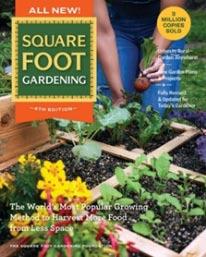
In All New Square Foot Gardening, 4th Edition, available December 3, discover the foolproof gardening method that has helped generations of gardeners around the world raise their own organic vegetables in less space, with less effort, and for less money than with traditional row gardens.
To enter to win the book, send an email by 5:00pm on September 30 to WashingtonGardenerMagazine@gmail.com with “Square Foot Gardening” in the Subject line and in the body of the email. Tell us what your favorite article was in this issue and why. Please include your full name and mailing address. Winners will be announced and notified on/about October 1. o
Are you trying to reach thousands of gardeners in the greater DC region/MidAtlantic area? Washington Gardener Magazine goes out in the middle of every month. Contact KathyJentz@gmail.com or call 301.588.6894 for ad rates (starting from $200). The ad deadline is the 5th of each month. Please submit your ad directly to: KathyJentz@gmail.com.
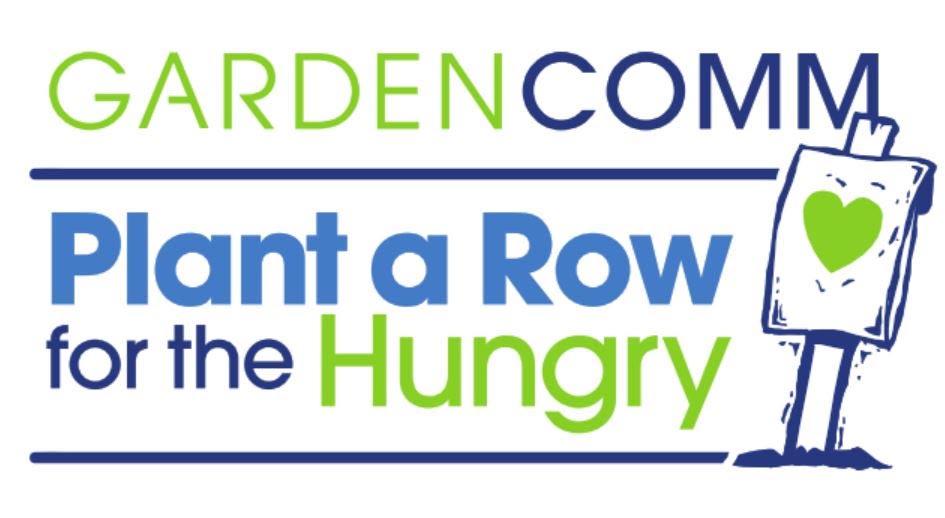
Plant a Row for the Hungry (PAR) is an easy program to participate in and really does not take any extra resources than what you may have in your garden. In normal times, about 35 million people wonder where their next meal will come from. Most of these are children. That’s where PAR steps in.
PAR is such a simple program: It urges gardeners to Plant A Row (or a container) dedicated to feeding the hungry, and then take the harvest to someplace or someone that needs it. Once you have donated, send an email to KathyJentz@gmail.com with the total (in pounds and ounces) of what you gave. That is all there is to it. Easy. Effective. Adaptable and Helpful.
My favorite article in the August 2024 issue of Washington Gardener was “Sunflowers of Lisbon (SoL),” for a number of reasons.
1. I was curious if some DC-area gardeners had a connection to Lisbon, Portugal.
2. I had never heard of SoL and now might visit it.
3. My parents had a field of sunflowers, just to stock their bird-feeders and sell to the neighbors to feed to their chickens. At nearly 70, I still have a heartshaped scar on my leg from running through the field as a child and tripping and falling on the stump of a sunflower after the field had been cut down for the fall.
4. I appreciate that they were able to stay open during the pandemic and offer people a chance for a mask-free, open-air outing. Also that they provided a place for vendors and musicians to do their thing during that tough time. I am a musician and had to pause just about all music work during the pandemic. I gather Patrick & Miller just run this as an entertainment venue...? Or do they sell the flowers or seeds to some farmers or oil renderers or snack processors or the like? I was hoping to find this detail of what they do with the crop in the article. Enjoyed it anyway.
~ Francine Krasowska
My favorite article in the August 2024 Washington Gardener is “Sunflowers of Lisbon.” The author did a great job of interviewing the owners and sharing gorgeous photos. Excellent piece.
~ Nancy Eyl
My favorite article was in the June 2024 issue of Washington Gardener Magazine is “Top 5 Extraordinary Slicing/ Sandwich Tomatoes” because it was informative and made me interested in growing those tomatoes next year.
~ Cheryl Derrington
My favorite article in the June issue of Washington Gardener Magazine was “ElderGrow,” using gardening as a therapeutic activity for people with dementia. As a former employee of the National Institute on Aging, it is a subject of long-term interest.
~ Anne Hardman o
By Zachary Intrater
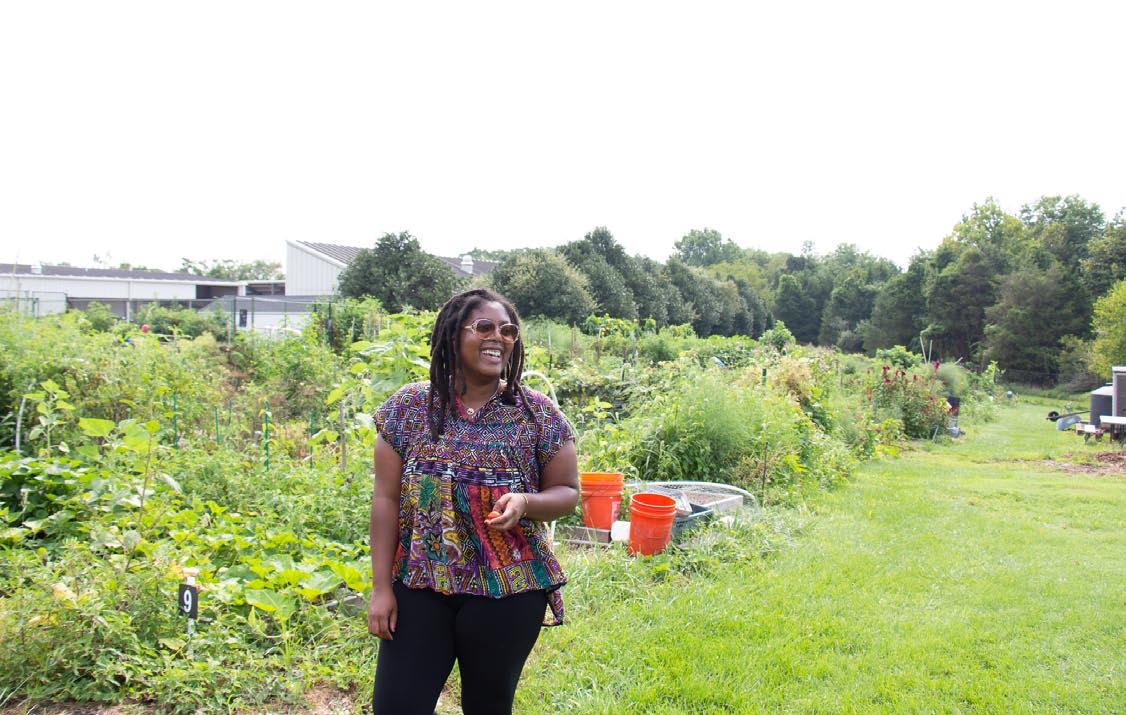
Michelle Nelson is currently the Community Garden Program Manager for Montgomery Parks in Montgomery County, MD, and is the first person to ever hold this particular position. Before she stepped into this role, she worked as an urban agriculture coordinator with University of Maryland Extension, where she managed multiple gardens. She also has experience as a lecturer with the Institute of Applied Agriculture at UMD.
Nelson is a proud HBCU graduate, graduating from North Carolina Agricultural and Technical State University in 2012 with a degree in environmental science. She received her master’s degree from the same university two years later in agricultural and extension education services. Nelson has also worked with the U.S. Botanic Garden, the Crossroads Community Food Network, and many other places. She’s excited to share a little more about herself with our readers.
Q: Tell us about yourself. Did you grow up in the Washington, DC region?
A: Hello, I’m Michelle! My favorite color
is purple and my junk food guilty pleasures are cup noodles and mint Oreos (don’t judge me it’s a nostalgia thing). I’m from Burtonsville, Maryland, a small corner of eastern Montgomery County. I like to call myself a TRUE DMV native— at any given point in my life I can connect back to any region in this area, up and down the I-95 corridor. From Baltimore to North Carolina, this is where my roots and life have centered. On my paternal side, my uncle had traced my lineage back to Monticello, so I’m really just an earthy girl with a love for nature, plants, and people.
Q: How and when did you become interested in gardening/agriculture? Has it always been a passion of yours since you were young?
A: My first interaction with gardening and agriculture was probably visiting Spicknall’s Farm in Beltsville, MD, as a child with my mom and then having the job of shelling lima beans or breaking the tips of green beans. My mother also had a few gardening moments while I was growing up, like growing beans and bell peppers in our backyard. My
grandmother always had tomato plants at her house, so it’s something I’ve always been around. Nature is more the passion that led me to the path of agriculture. I’ve always been an outside kid and a plant girl—nature has always been a solace for me, so when I decided to pursue environmental science in college, I really just wanted to know more about the science of outside and the name of any and all plants. When I went off to North Carolina A&T State University, that’s when all my classes were on the research farm, and I really fell in love with agriculture and started learning way more, I just loved it and the career opportunities seemed endless.
As I continued working in the field (literally and figuratively), I discovered that like most Black Americans, my great grandparents had pig farms (on both sides), so the signs that this was right for me just kept showing up.
Q: How long have you been with Montgomery Parks and how did you come to start working with them?
A: It has been eight years with Mont-
gomery Parks in November! My first job was with University of Maryland Extension. I was an urban agriculture coordinator, managing two gardens—one that primarily served refugee families.
Extension was an amazing start for my career, but I needed a life adjustment, a little more responsibility beyond two gardens, and a little more money (laughs). With student debt, I was working two jobs and needed to work smarter. My position was the first career position for the Montgomery Parks’ Community Garden Program. Most park-administered community garden programs in the country are run by part-time staff, but with strong advocates and an appropriate budget, a full-time position was created. This was a perfect career move for me and in my home county, so it was a no brainer. Parks was not on my radar for agriculture and gardening, but I’ve had a lot of job experiences and Montgomery Parks reminds me of all of them in one place, which keeps my days interesting.
Q: What exactly does your role as Community Garden Program Manager entail?
A: As Montgomery Parks’ Community Garden Program Manager, my job entails—everything? Where do I begin? We have five major priorities that guide the program: garden maintenance and expansion, reducing food waste/food recovery, internal and external partnerships, education, and accessibility. I developed those when I started in the position—identifying the big parts of the job, focusing the work, and providing a large umbrella for how the program could grow over the years.
We have 14 community gardens across the county, so much of my job encompasses those priorities. My job also entails being the representative of the program, developing long- and short-term plans for the program, identifying new sites, managing new garden projects, and serving as the subject matter expert in the Parks Department on food systems. I can’t omit the relationship-building that my position also entails—customer service to all the gardeners, bonding with the 80% returning and veteran gardeners, training and welcoming new gardeners each year, working with internal staff on pro-

gramming, etc. There really is a lot to the job and I’m very proud of what I’ve created as the first program manager.
Q: Throughout your whole career in gardening/agriculture, what is one accomplishment or goal that you’ve met that you’re particularly proud of?
A: My WHOLE career? Wow. I have a couple, but I’m not someone who firmly sets goals. I’ve always hated it since second grade, when we had to do S.M.A.R.T. goals, because it is sometimes felt too rigid for me. But specifically, I’m proud I’ve had the privilege of working at the U.S. Botanic Garden, receiving the Excellence in GIS Award and presenting at the Esri User Conference, being a small business owner for a stint during the pandemic, teaching at the University of Maryland, being a working mom, being featured on the Edible Activist Podcast… and now in Washington Gardener is a pretty big deal, too. I’ve been very fortunate to accomplish lots of goals and hit big milestones. I’m not done yet. Maybe one day. I will go back and teach at my alma mater or get another degree; who knows? I’m just proud of myself for honoring goals and opportunities that best reflect me and my contributions to this work. I’ve grown so much and this career field allows you to expand as much as you want. There are safe risks or big risks—you can always decide what works best.
Q: Why do you believe that food is such an important connector of culture?
A: My interactions with food have shaped me and they shape others, more than they realize. Food is related to our overall well-being and overall connection to being—people, place, belonging, and so much more.
For me, seeing or creating the entire
process of plants from harvest, to a loving meal, to conversation at the table and the memories it creates—it somehow gives me purpose. I wish everyone saw it that way. Imagine how different our encounters would be with one another, regardless or our differences. One of my favorite things is connecting with someone on something they think I’ve never experienced. Food is one of those “safe” places where people can see and share their identity. In short, it connects all of our cultures and identities—very quickly, very simply, and very memorably.
Q: Do you have a personal favorite plant/crop?
A: I love lavender and rosemary because I love their medicinal and spiritual properties.
Q: What advice would you give to any young people looking to get into gardening/agriculture?
A: Gardening and agriculture are not the place to become a millionaire, but they are the place to listen, learn, observe, eat well, and take your time. Just like with life, all things in the garden can teach you something new, just be still and be quiet. You may think nothing is happening, but something is always happening in your career, in your life—and then boom, you have new growth or a new opportunity and whatever was happening makes sense and is something beautiful to enjoy. Volunteering is a great way to learn if this is the path for you. If you want to hear more about my career path or are unsure of the options, I’m available and love mentoring.
Q: Any final thoughts or statements you’d like to share with our readers?
A: I very much appreciate the opportunity to be profiled/featured. I’m very appreciative of the garden and nature that gives me lessons and restores my soul. Look out for me, world. o
Zachary Intrater is a senior in the Philip Merrill College of Journalism at the University of Maryland. This fall semester, he is an intern at Washington Gardener Magazine.
Photos by Topaz McFarlane with Melissa Jones of FoodTalksncolor.
By Kathy Jentz
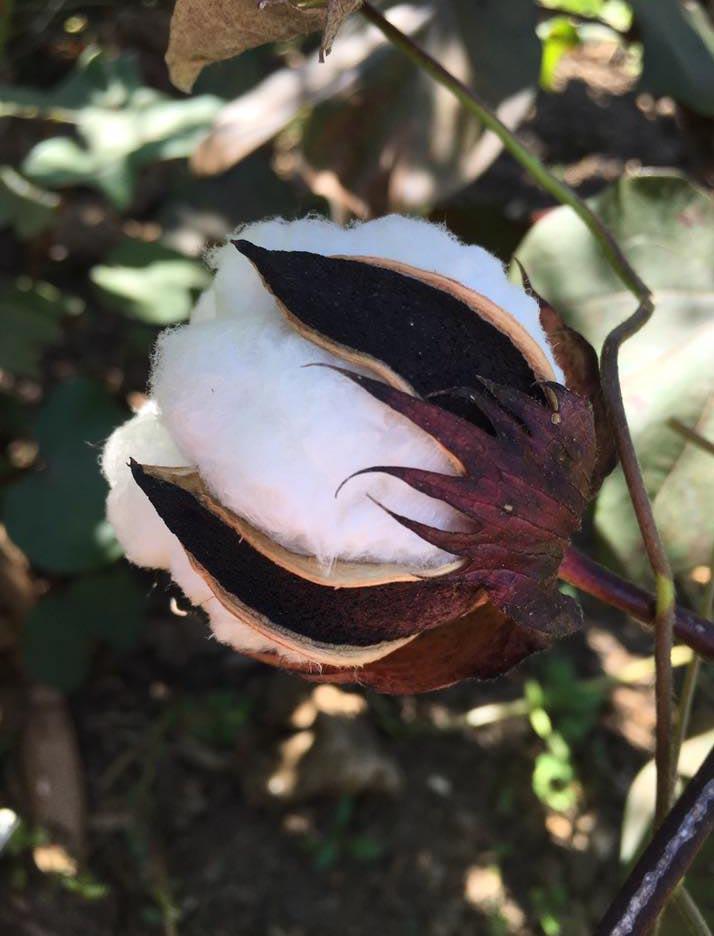
Cotton (Gossypium spp.) is a plant family with a long and tangled history. It has been cultivated and used by humans for thousands of years. Cotton is native to the tropical and subtropical regions of the Old and New Worlds. There are about 50 Gossypium species.
Growing Cotton ornamentally is gaining popularity. It is an interesting and unique plant when used as a “thriller” in a container or in a garden bed planting. It especially pairs well with tropical-themed gardens.
In USDA Zones 8–10, Cotton is easy to grow from seed that is direct-sown in the soil once the chance of last frost has passed in the spring. In Zones 5–7, it can be started early under grow lights indoors, similar to tomato plant timings.
Cotton is an annual crop. It prefers full sun, well-draining soils, and average moisture.
The plant has maple-like leaves and is tall and spindly, similar to Okra, Hollyhocks, and other members of the Mallow family. The flowers are hibiscus-like and form seedheads as they dry and mature on the plant, which are the white fibrous “bolls” of cotton fluff. You can cut these off and dry them to use in crafts and collect the seeds for next year’s plantings.
Some attractive varieties to try in a home garden setting include ‘Red Beauty’, ‘Albe Red Variegated’, and ‘Black Beautiful’.
Kathy Jentz is the editor of Washington Gardener
By Melinda Myers
Take your garden to new heights with alliums. This ornamental member of the onion family provides welcome color as spring bulbs fade and before summer perennials fill our gardens with colorful blooms. Add alliums to the USDA Zone 4–8 garden in fall when planting your other spring flowering bulbs like tulips and daffodils.
Most people have seen pictures of the giant allium, but there are many other options of flower sizes and heights suitable for any size and style garden. Most allium flowers are globeshaped and all are made of tiny florets. They make great cut flowers, the pollinators love them, and deer tend to leave them be.
Plan for months of color by including a variety of alliums that bloom from late spring through early summer. Longfield Gardens’ Planning Guide for Alliums (Longfield-gardens.com) showcases the various alliums, with their size and bloom time, to help you plan. Dress up the front of a flowerbed or rock garden with Allium karataviense. It may be small in stature at only 8 to 10 inches tall, but the broad grey-green leaves and 5-inch round, silvery-pink flowers provide big impact in the late spring garden.
Add years of spring beauty with Purple Sensation. Its shimmering 4inch diameter, violet-purple flowers are held above the leaves on 24 to 30" tall stems. It provides nice height and vibrant color to the early season garden. You will enjoy these alliums and their offspring for years to come.
For something uniquely different, add Allium bulgaricum, also known as Nectaroscordum bulgaricum, to perennial and informal gardens. The clusters of drooping cream and burgundy bellshaped flowers are followed by seedpods that lift themselves skyward. This provides an interesting vertical accent in the garden.
Gladiator and Globemaster are sure
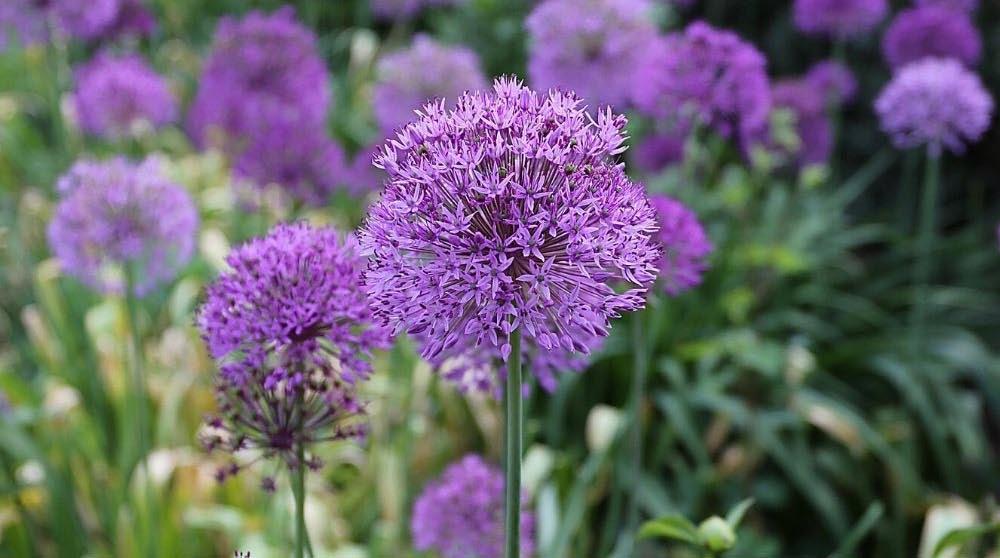
to have passersby and visitors stopping to take a second look at your garden. Mix them in among perennials and add to mixed borders. Gladiator has blueviolet, 6-inch diameter flowers that are smaller than Globemaster but Gladiator blooms earlier and stand a foot taller, and the leaves are long-lasting. Both are sure to grab your attention and that of pollinators.
Stretch your enjoyment into early summer with Ambassador. Its dense 5- to 6-inch, violet-blue flowers are a deeper color than most alliums. What’s even more impressive is these large flowers are atop four- to five-foot stems. Like the other alliums, bees, and butterflies love it.
It’s no surprise that Allium christophii is a favorite among gardeners. The 8to 10-inch diameter, violet-pink flowers have spikey florets and a silvery sheen that makes them look like globes in the garden. Although this allium is only 12–18" tall, it has a big presence in the garden and is very long-lasting.
Allium schubertii produces even larger, 12-inch diameter flowers on stems of a similar height. Some of the starlike florets are closer to the center of the flower than others and this makes the blossom appear to be expanding, like fireworks in the garden. Save some
of the seedheads and use them in dried flower arrangements.
The flowers of heirloom Allium atropurpureum are dome-shaped rather than round. Their dramatic, darkburgundy color and upright stature add structure to the garden. They are also long-lasting as cut flowers.
End the season with Drumstick allium. The egg-shaped flowers are raspberry on top and green on the bottom, with long slender stems. They are perfect grow-through plants and good companions for ornamental grasses.
Add a variety of alliums to your garden this fall and enjoy the added color, texture, and height this group of plants provide. You and the pollinators will be glad you did. o
Melinda Myers has written more than 20 gardening books, including the recently released Midwest Gardener’s Handbook, 2nd Edition and Small Space Gardening. She hosts The Great Courses “How to Grow Anything” instant video and DVD series and the nationally syndicated Melinda’s Garden Moment radio program. Myers is a columnist and contributing editor for Birds & Blooms magazine and was commissioned by Longfield Gardens for her expertise to write this article. Her website is www. MelindaMyers.com.
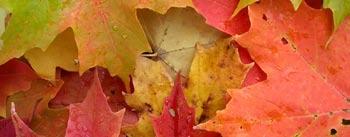
As the days grow shorter and a subtle chill fills the air, one of nature’s most fascinating transformations begins across the varied landscapes of the United States. From the soaring mountain ranges in the West to the more serene hills and mountains of the East, fall in America is simply stunning—and a big money-maker as well.
They say money doesn’t grow on trees, but in communities near national forests in fall, the locals might have another take on that adage: When tens of thousands of leaf peeping tourists come to be delighted at the sight that autumn paints on the leaves of many a tree, they want to stay awhile and soak it all in. The sightseers might stay overnight or just for a day’s drive. And perhaps these leaf-obsessed visitors might buy a trinket to remember the beauty they’ve seen or have a meal in a local restaurant overlooking the colorful landscape. Whatever these leaf-loving acolytes do, they are spending hundreds of millions of dollars every year heading out to see the colors of fall.
And why not?
In October, deep in the Appalachian Mountains, Virginia’s Shenandoah Valley transforms into a mosaic of brilliant orange, yellow, red, and gold as Oak, Maple, and Hickory trees co-mingle to create a fantastic autumn display. The George Washington and Jefferson National Forest has many vantage points to see the breathtaking scenery.
As the leaves change and the air turns crisp, national forests in these diverse regions of America beckon travelers to immerse themselves in the magic of fall. Beyond the stunning visuals though, there’s a deeper connection to nature that occurs during this season. It’s a time for reflection, for hikes among the rustling leaves, and for savoring moments of tranquility amidst the grandeur of these forests.
Fall color tourism is a significant
contributor to the economies of those regions and the many not mentioned. Predictably, tourists flock to these areas during the autumn season to witness the stunning foliage transformations, leading to a financial boost in various sectors and creating an economy where money does indeed “grow” on trees.
Whether you find yourself wandering through the rugged terrain of Oregon’s Cascade Range, gazing in awe at the golden Aspens of Colorado’s Rockies, savoring the peaceful beauty of Virginia’s Shenandoah Valley, or exploring the quintessential fall scenes of New England, one thing is certain: The autumnal splendor of America’s national forests is a treasure worth experiencing, one leaf at a time. o
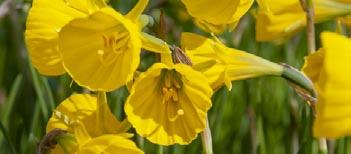
With their distinctive trumpets and sunny, fresh colors, daffodils bring lots of joy to the garden. Many people have no idea, however, how diverse this collection of spring-flowering bulbs is.
Daffodils (Narcissus spp.) are spring bloomers that cheer up the garden when other plants, trees, and shrubs are still hibernating. The daffodil family consists of many types. The very smallest will grow 4 inches high, and the largest up to 2 feet. Their flower size varies as much as their height. And don’t be fooled: They don’t just come in yellow. The flower color can be any shade of white, yellow, or orange. So much diversity!
The daffodil family is huge and consists of about 35 different varieties. The wild daffodil, the large-crowned, and the small-crowned daffodil are the best-known varieties. The large number of different varieties includes about 23,000 variants and cultivars. It’s enough to make your head swim. For more clarity about the various shapes, colors and smells, you can read about the 12 main groups here:
• Bulbocodium hybrid daffodil
This frivolous-looking daffodil is also called the petticoat daffodil and stands out for its relatively large crowns and
small petals. The flowers appear to trumpet non-stop music into the world.
• Cyclamen-flowered daffodil
This daffodil has petals that stand up a little. If you look closely, you can see that it bends its flower slightly toward the ground.
• Double daffodil
Graceful double daffodils offer twice the fun. They produce one or more flowers per stem, with double petals, double trumpets, and sometimes even both.
• Large-crowned daffodil
Each stem of the large-crowned daffodil produces one striking flower. These flowers look like wild daffodils, but their crowns are slightly longer.
• Jonquilla and apodenthus daffodil
This cheerful little daffodil produces clusters with up to five flowers per stem. The flowers are delicate and also emit a delightful scent.
• Small-crowned daffodil
This fun daffodil has flowers that are very similar to wild daffodils, but with shorter crowns.
• Poet’s daffodil
The poet’s daffodil understands the poetry of nature. Its small yellow trumpets with red border and green heart, contrast magnificently with its snowwhite petals.
• Narcissus pseudonarcissus
This is a wild daffodil—one of the oldest Stinzen plants. The contrast between its pale-yellow petals and the bright-yellow crown is lovely and striking. The flower droops a little bit.
• Edinburgh daffodil
This is also known as the butterfly daffodil. It produces multiple flowers with crowns for their collars that are deeply split and almost lie on the petals.
• Tazetta daffodil
If you want loads of flowers, this is an excellent choice. Its sturdy stems produce up to 20 often fragrant flowers.
• Angel’s tears (Narcissus triandrus)
The elegant Angel’s tears produces two or more flowers per stem. A striking feature is that the outer petals bend gracefully upward.
• Wild daffodil
These daffodils have large trumpets; they are the same length as or longer than the petals.
You can find more inspiration and information about flower bulbs at www. flowerbulbs.com. o
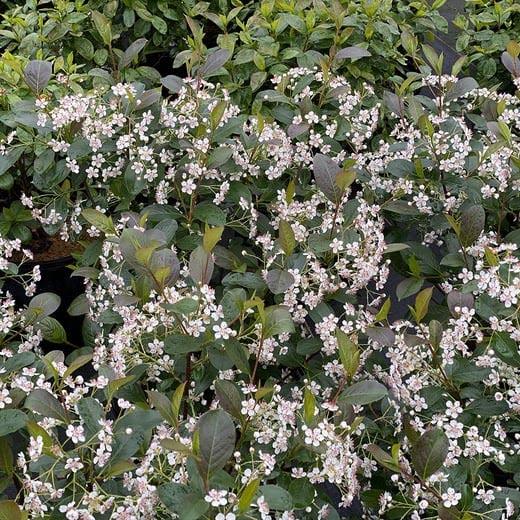
Low-Scape Snowfire® (Aronia melanocarpa)
This durable native cultivar can be used as a hedge, foundation planting, wildlife garden, and more. Come spring, it’s positively snowed under with white flowers, and that heavy bloom set results in an equally heavy fruit set come late summer/fall. Fall is also when the “fire” part of its name comes into play, as its foliage blazes red and orange.
Plant Facts:
• Deciduous Shrub
• Part Sun to Sun
• USDA Hardiness Zone: 3–9
• Height/width: 4–6 feet by 3–4
• Deadheading not necessary
• Native to North America
• Heat-Tolerant
• Drought-Tolerant
• Salt-Tolerant
• Erosion Control
• Bog/Rain Garden Plant
This is a 2024 introduction. For more information, go to https:// www.provenwinners.com/. o
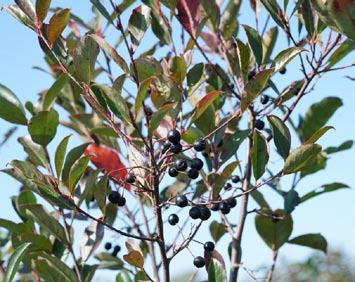

• Fall Garden Prep
• Garden Theft and Beauty
• Meet the New Intern
• Seed Libraries
See more Washington Gardener blog posts at WashingtonGardener.blogspot.com o
• Keep an eye out for the first frost date. In Zone 6, it is expected between September 30 and October 30. In Zone 7, it is predicted for between October 15 and November 15.
• Divide and transplant perennials—in particular, peonies and iris.
• Pick apples at a local pick-your-own farm or visit a local farmer’s market.
• Pot up rosemary and chives for over-wintering indoors.
• Take cuttings from coleus and begonias to propagate and overwinter indoors.
• Look out for poison ivy vines, which will turn crimson in the fall and be easy to distinguish from other vines.
• Check your local garden center for end-of-summer bargains.
• Put netting over your pond to prevent the accumulation of leaves and debris.
• Start feeding birds to get them in the habit for this winter.
• Attend a local garden club meeting or plant exchange.
• Pick mature tomatoes and peppers to ripen on your window sills.
• Turn your compost pile weekly and don’t let it dry out. Work compost into your planting beds.
• Remove undeveloped or shriveled fruit from fruit trees and compost them.
• Plant evergreens for winter interest.
• Plant garlic bulbs.
• Collect plant seeds for next year’s planting and for trading at the annual Washington Gardener Magazine Seed Exchanges.
• Plant hardy mums and fall season annuals.
• Fertilize your lawn and re-seed if needed.
• Dig up your Gladiolus, Canna, Caladiums, and other tender bulbs; cut off foliage; let dry for a week; and store for the winter.
• Transplant trees and shrubs.
• Harvest your herbs often and keep them trimmed back to encourage leafy growth.
• Bring in houseplants if you took them outdoors for the summer.
• If your conifers start shedding their needles or your spring bulb foliage starts peeking out of the ground, don’t worry. This is normal for our autumn cycle.
• Leave hummingbird feeders out until October 15.
• Start bulb plantings of early-spring bloomers at the end of the month.
• Watch your pumpkins/squash. Harvest them when their rinds are dull and hard.
• Divide ornamental grasses.
• Cut herbs and flowers for drying indoors.
• Plant strawberries in a site with good drainage for harvesting next spring.
• Look out for slug eggs grouped under sticks and stones—they are the size of BBs and pale in color.
• Plant cover crops in vegetable gardens and annual beds (for example, rye, clover, hairy vetch, and winter peas).
• Begin conditioning the Poinsettias and Christmas cacti to get them ready for the upcoming holiday season.
• Bring Amaryllis indoors before a hard freeze. Repot every other year at this time. Store in a cool, dark place and do not water until flower buds or leaves emerge.
• Your summer annuals will be reviving now with cooler temps and some rain. Cut back any ragged growth and give them some fertilizer. They should put on a good show until the first hard frost. o
• Saturday, September 21, 9am–4pm Garden Discovery Day Gardening programs for children and youth from kindergarten through high school, with a small charge for each attendee, from $10–$18, to cover the materials and program expenses. Hosted by Montgomery County Master Gardeners. Held at Montgomery County Fairgrounds, Gaithersburg, MD. Spots are limited so registration is encouraged at https://www.eventbrite.com/ e/2024-garden-discovery-day-tickets734763065107?aff=oddtdtcreator.
• Saturday, September 21, 6–10:30pm American Horticultural Society Gala
The 2024 American Horticultural Society (AHS) Gala at River Farm is cohosted by Skipp Calvert, member of the AHS Board of Directors, and Lauren Bishop, award-winning Realtor at McEnearney Associates. The annual soirée not only highlights the vibrant culture of gardening and horticultural practices but also raises vital funds to support the society’s outreach and educational programs, and the stewardship of River Farm. Held at River Farm, 7931 E. Boulevard Dr., Alexandria, VA. The gala will feature cocktails, dinner, dancing, and mingling, set in River Farm’s gardens Attire is black-tie. Individual tickets are $375 each.
• Saturday, September 28, 9am—2pm 2024 Northern Alexandria Native Plant Sale
Twelve vendors will be at this event—the largest native plant sale in the Washington, DC, area. Held in the parking lot of The Church of St. Clement at 1701 N. Quaker Lane, Alexandria, VA. Free to attend. See www.facebook.com/NorthernAlexandriaNativePlantSale.
• Saturday, September 28, 9:30am FONA Volunteer for National Public Lands Day
Join the Friends of the National Arboretum (FONA) in the Washington Youth Garden to plant native and fruiting trees to help control invasive weeds around the public fruit and vegetable garden. If you don’t want to volunteer, you can still
celebrate National Public Lands Day in the garden. Join FONA for family-friendly activities from 11am to 1pm with partners from the National Environmental Education Foundation, U.S. Forest Service, Buffalo Soldiers, and Corazon Latino. Details at FONA.org.
• Saturday, September 28 Orchid Auction
The National Capital Orchid Society (NCOS) Auction will again be held at Harlow Hall at North Chevy Chase Christian Church in Chevy Chase, MD. Sales tables will feature some hard goods for sale in addition to plants. The plants to be auctioned off will be displayed separately before the live auction. A simple lunch special will be provided for auction participants for $5. Open to the public. Details at https://ncos.us/.
• Saturday, October 5 Weed Wrangle
Tudor Place is participating in the annual National Capital Weed Wrangle, an area-wide volunteer-powered effort to protect our natural areas through removal of invasive plant species. Join fellow garden lovers and the Tudor Place garden team to help eradicate invasive plants from our historic garden. Details at https://tudorplace.org/.
• Saturday, October 5
Growing Community: Making Good Soil
Join fellow gardeners on Saturdays through October. Hosted by Smithsonian’s Anacostia Community Museum. Register at https://www.eventbrite. com/e/growing-community-makinggood-soil-tickets-840533066027?aff=e relexpmlt.
• Thursday, October 10, 6:30–8:30pm 2024 October Night on the Farm @ Common Good City Farm
A Night on the Farm cocktail party at Common Good City Farm in Washington, DC, includes notable local businesses, chefs, and bartenders who will each serve a distinctive dish or beverage, featuring Common Good produce. Attendees can explore the farm and enjoy the atmosphere as they try all the dishes. This is a standing cocktail event catered by several local restaurants and
chefs. Each ticket purchase includes two drink tickets. Tickets $65+. Details at https://events.humanitix.com/2024october-night-on-the-farm.
• Saturday October 19–Sunday, October 20
Loudoun County Fall Farm Tour
The Loudoun Fall Farm Tour offers a cornucopia of experiences for visitors of all ages, featuring a diverse array of farms showcasing the finest products that Loudoun County, VA, has to offer, including honey, mushrooms, traditional vegetables, garlic, and craft beverages. Attendees will have the opportunity to immerse themselves in Loudoun’s agricultural heritage. Details at https://loudounfarms.org/farmtour/.
• Thursday, October 24, 7–8:30pm
Dealing with Deer and Other Mammal Pests in Your Garden
Bambi may be cute, but he would love to make a feast of your garden. Learn some proven and humane tactics to keep your edible and ornamental gardens safe from deer, rabbits, rats, squirrels, groundhogs, and other warmblooded creatures. Instructor Kathy Jentz, editor of Washington Gardener Magazine, will also touch on design strategies and plant selections. This is a Live Zoom lecture with audience Q&A. Recordings will be made available afterward to registered students. Sign up at ActiveMONTGOMERY. Course #PBG0153. Fee: $15.
See updated event listings on the Washington Gardener discussion list. Join by emailing WashingtonGardenersubscribe@googlegroups.com.
To submit an event for this listing, email washingtongardenermagazine@gmail. com with “Event” in the subject line. Our next deadline is October 5 for the October 2024 issue, for events taking place after October 15. o
By Savannah Scollar
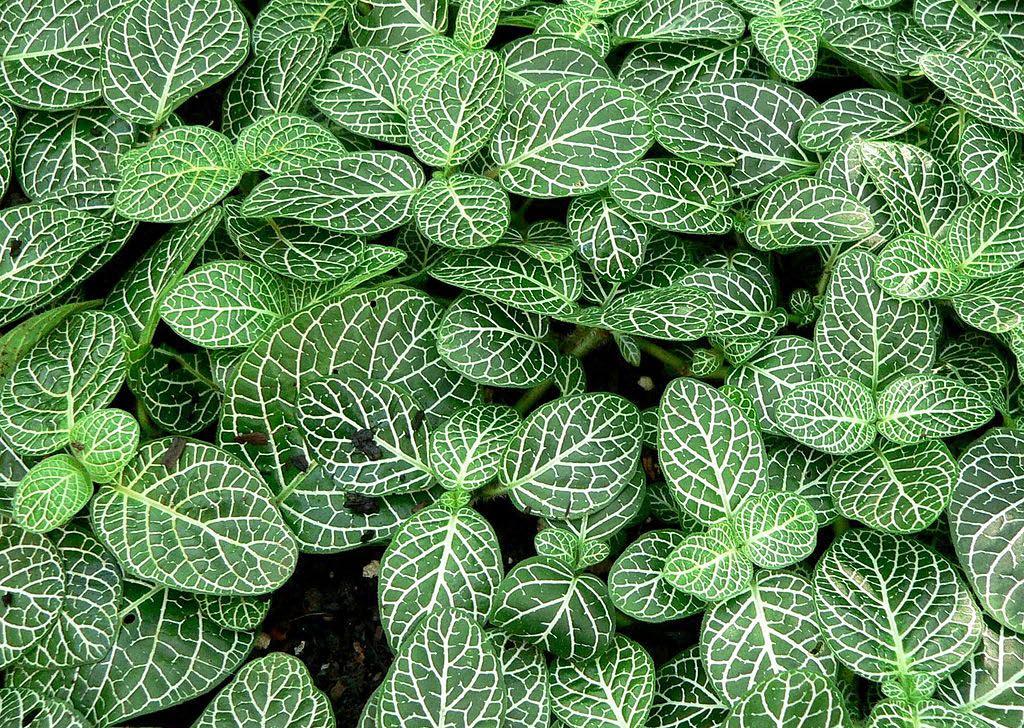
There’s no need to be nervous when it comes to nerve plants (Fittonia albivenis)! They are also known as mosaic plants and grow beautiful stripey (and slightly fuzzy) leaves. You’ll find wavy varieties; pink, red, and white stripes; small leaves and large. It’s delightful in its variegations.
As houseplants, nerve plants are known for being “dramatic” in a way that’s actually extremely helpful. If their soil gets too dry, they’ll collapse entirely, wilting woefully like a lettuce plant in the hot sun. This wilting acts as a clear visual warning. It’s plant language for: “Water me today, or else!” Once watered, a nerve plant will recover within a few hours. Soon, it’ll look as if nothing was ever the matter. “Tantrum? What tantrum?”
If you notice your nerve plant fainting frequently, drooping as often as twice a week, it’s time for a bigger pot. Your nerve plant is growing, and it’s drinking too fast for the soil to keep up. More soil can store more water, satiating those thirsty roots.
Although it’s cool to watch it bounce back, it’s probably best to avoid letting your nerve plant get to the point of flopping over. The plant gets stressed and can end up with lost or damaged leaves. To keep a nerve plant happy in its pot, add water when the soil surface is dry to the touch. I always water with, at most, a quarter as much water as there is soil in the pot.
I’m a pretty big fan of nerve plants, and I’ve collected quite a few varieties. They’re somewhat prone to mutating and growing leaves with different colors. I have one plant that I picked out for its section of strange camouflagepatterned leaves. One day, I’ll propagate some clones of it, turning it into a new cultivar if I’m able.
Usually, nerve plants are sold without any specification of the particular variety you’re getting. However, labeled or not, more than 100 nerve plant cultivars have originated from one source: Schoenmakers Tropische Potcultures. This family-run greenhouse in the Netherlands grows more than 10 million nerve plants each year. I find it sweet that many of their cultivar names honor various members of the Schoenmakers family. The Josan line was named for the founders of the company: Jos and Anneke Schoenmaker. The Anne line was an additional homage to Anneke, mother of the three brothers who currently run the company.
I grow nerve plants on a much smaller scale—nowhere near 10 million. These plants are rather slow-growing, but very tolerant of low light. They’re amazing for terrariums, especially small ones. Nerve plants are nowhere near as picky as other terrarium plants, so they’re great for beginners. To prepare baby nerve plants for terrariums, I pinch off the top of a plant—removing
a pair of leaves and a bit of stem. The mother plant will branch below this point, creating two new pairs of leaves, side by side. The baby-to-be goes into a clear parfait box with a thin layer of slightly moist soil. The box is topped with a lid and given a small amount of light. Two weeks later, we’ll have roots. Single leaves can also be used as well for propagation, but they take much, much longer to grow into usable plants. You’ll spend months watching the leaf grow new roots, before any additional leaves are formed.
Nerve plants might remind you of a few other houseplants. In the same family, Acanthaceae, you’ll find the polka dot plant, Persian shield, purple waffle plant, zebra plant, and ruellia. Out of this family of plants, the nerve plant is the one I’d recommend most, and is definitely one of the most popular. If you’re looking for something small and colorful (not to mention petfriendly), a nerve plant is the way to go!
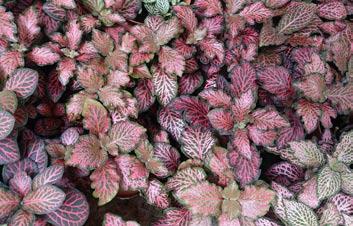
Now, I’ve got a whole rabbit hole to go down. The nerve plant’s scientific name, Fittonia, is a tribute to Sarah Mary and Elizabeth Fitton. Conversations on Botany, written by the pair of scientist sisters, contributed to botany’s popularity among women in Victorian England. The Victorian era is my jam. I love learning about women’s history, and, well, you can probably guess how I feel about botany. There’s definitely more to explore here! o
Savannah Scollar opened Easy Little Plants in July 2023 at age 21. It’s a houseplant shop in Olney, MD. She loves doing research, teaching private workshops, decorating with houseplants, and arranging adorable terrariums. Contact her through her website: easylittleplants.com.
By Lovepreet Singh

Do you grow peas, beans or other legumes in your backyard or garden?
Have you ever heard about seed inoculation and how you can use it to produce more yield? This article explores the use of seed inoculation for plant growth, which helps you get the most out of your plants
Seed inoculation can be understood as adding or mixing useful bacteria to garden seeds. (Farmers also use inoculated seeds on farms.) The purpose of mixing is that the correct type of bacteria can establish a successful symbiosis with the plant to fix atmospheric nitrogen for the plant so you do not have to apply more fertilizer. Inoculation can also create better growth and yield of the crop.
Seed treatment is a bit different from seed inoculation. Seed treatment is when you expose seed to heat or cold, and soak it in water. Chemicals are then applied that will protect the grow -
ing plant from pests or for better seed germination.
Inoculation is important especially if the legume you are planting in soil where it was not planted in previous years. Then the inoculant will help in increasing the population of bacteria that will act in symbiosis with the plant to fix nitrogen for the plant.
Using peas as an example, seed companies would isolate the bacteria from root nodules of growing peas that are already healthy. They grow that bacteria in a laboratory. Usually this is done on a mass production scale for efficiency. The bacteria are then mixed with peat to increase volume—and the inoculant is ready.
You can purchase pre-inoculated seeds in which bacteria and seeds are already mixed. Many companies sell these seeds. You can also buy an inoculant mixture alone, and mix it with your seeds or in your soil. A good tip is to add some sugar or sticking agent to help the inoculant mixture stick to the seed or soil if you are mixing it by yourself. Usually, farmers adopt the inoculant mixture process when they must plant on a bigger scale. Soil inoculation can be a good method if you have already planted your seeds.
Seed inoculants are safe and have been found to have no negative effects on seeds—even if you over-inoculate. It means they are perfect for home
gardeners, and they do not need additional practice to use.
The inoculants should be handled with extra care because they contain fragile and sensitive microorganisms. Exposing inoculants to heat, direct sunlight, excessive moisture, or extreme conditions can kill microbes present and leaving it ineffective (just like many probiotics should be stored in the refrigerator).
The bacteria that establish a symbiotic, which relationship with the legumes and help in fixing atmospheric nitrogen belongs to genus Rhizobia. The different species of this bacteria are specific according to the legume or plant. Rhizobia infects the root hairs of legumes and forms little swellings on roots of plants called as root nodules. These nodules convert the atmospheric nitrogen into soluble nitrogen compounds through complex biochemical processes. Once they do that, this soluble nitrogen can be used by the plants. In return for helping the plant with its nitrogen requirement, the plant helps the bacteria. (thus, it’s called symbiotic). The plants make carbohydrates that the bacteria then “eat.” If you uproot a plant and see greater number of nodules on roots, you can tell this plant has greater potential for nitrogen fixation. If you’re interested in seeing whether the process is working, try this test: Cut down the middle of a nodule. If it shows a red color, that means it is actively working. Like hemoglobin in humans, plants have leghemoglobin, which binds with atmospheric oxygen and helps the nitrogen fixation process. Like hemoglobin, leghemoglobin turns red when in contact with oxygen, testifying to its active status.
Some fungi and bacteria provide nutrients to plants both by acting in symbiotic relationship or as free-living nitrogen fixers. One special mycorrhizal fungus which also forms symbiotic relationship with the plants and increases the uptake of phosphorus and water. It also has been found that mycor-
rhizal fungi increase the tolerance of some plants to different environmental stresses.
Some microbes do not form symbiotic relationships with the plants but are still beneficial to them. If they promote plant growth, they are called biofertilizers. When they suppress plant diseases or pests, they can be called plant resistance stimulants or biopesticides.
Biofertilizers are, again, the living microorganisms live around the root area of plants and secrete some organic acids. These chemicals either dissolve the minerals and make nutrients available to plants or act as growth hormones to promote root/plant growth. The biopesticide or biocontrol agents are what suppress plant diseases and make plant healthy. An excellent example is Trichoderma, which kills the bad fungus by secreting harmful chemicals or stealing nutrients from them.
Why garden with seeds? Anyone who plants a seed is investing in hope. That’s one of the attractions of seeds. For the gardener, it could be hope for a beautiful flower, or perhaps a delicious zucchini squash. For our farmers, seeds are the hope of this year’s yields of produce, cash crops, or forage. No matter the size or shape of the seeds, they all can bring forth new life. At Crop Science Society of America, we hold seeds in very high regard. o
This article is sponsored and written by members of the American Society of Agronomy (ASA) and Crop Science Society of America (CSSA). Members are researchers and trained, certified professionals in the areas of growing the world’s food supply while protecting the environment. They work at universities, government research facilities, and private businesses across the U.S. and around the world.
kathyjentz@gmail.com or call 301.588.6894 for ad rates The ad deadline is the 10th of each month. Please submit your ad directly to: KathyJentz@gmail.com

The Urban Garden: 101 Ways to Grow Food and Beauty in the City is all about small-space gardening solutions! By Kathy
Jentz and Teresa Speight
Published by Cool Springs Press/Quarto Homes Order it today at: https://amzn.to/3yiLPKU

The GardenDC podcast is all about gardening in the greater Washington, DC, and Mid-Atlantic area. The program is hosted by Kathy Jentz, editor of Washington Gardener Magazine, and features guest experts in local and national horticulture. The latest episodes include interviews with experts on Fall Garden Prep and Containers for Humid Climates. You can listen online at https:// washingtongardener.blogspot.com/ or on Spotify, Apple, etc o
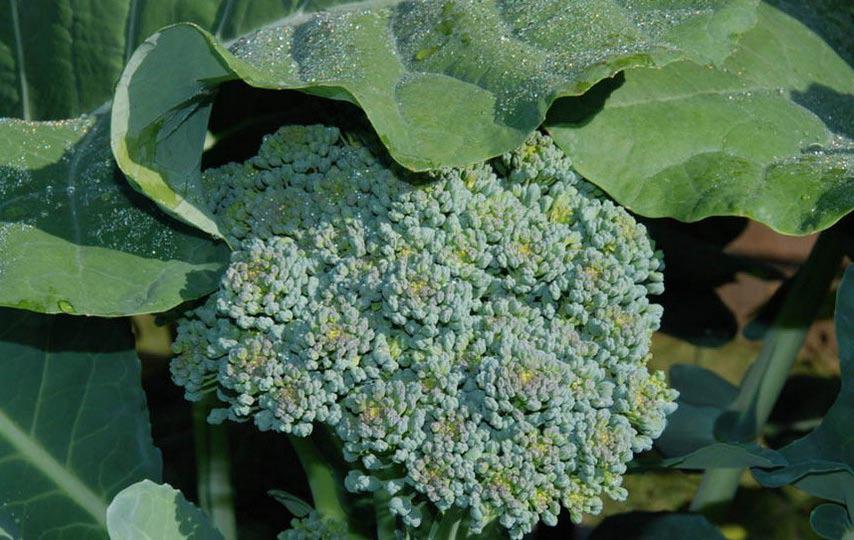
Text and photos by Barbara Melera
Broccoli is among the easiest vegetables to grow from seed. Some varieties are better suited for spring planting and some varieties are better for fall planting. However, all varieties can be started in either season and will produce.
Native to Europe and Asia, broccoli belongs to the Brassica family of vegetables, the largest vegetable family known, which includes cabbages, cauliflowers, Brussels sprouts, collards, kale, kohlrabi, turnips, and rutabaga. In fact, broccoli is nearly identical to cauliflower, the only differences being the green color of broccoli and the fact that cauliflower tolerates heat while broccoli does not.
There are fundamentally two types of broccoli: The older variety called sprouting or asparagus broccoli belongs to the Italica group and the heading variety belongs to the Botrytis group. The Italica variety is thought to have developed from a form of European wild cabbage and originated in the Eastern Mediterranean. It made its way to Italy by the 17th century. As it spread to Northern Europe, it became known as Italian Asparagus. The heading variety, which
was generally referred to as Calabrese, forms one dense head. The head can be purple or green.
Italian immigrants brought broccoli to the U.S. in the early 1800s.
Calabrese (pictured above) came to the U.S. in the 1880s with Italian immigrants and initially forms a large, green head, usually 6 to 8 inches in diameter. Once the head has been harvested, it may produce green sprouts until early to mid-winter. The 18–30 inch tall plants tolerate frost very well.
Broccoli Calabrese often will not form sprouts once the main head has been harvested.
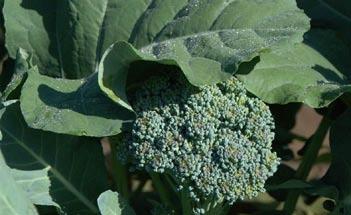
DeCicco (pictured here) is a great broc-
coli for summer planting because of its much shorter time to maturity. It came to the U.S. with Italian immigrants in the 1890s. The 24–36 inch plants produce 4–6 inch heads followed by an abundance of side shoots. Broccoli is very cold-tolerant, so frost is not a problem until the really hard frosts hit in winter. Plants continue to produce side shoots until mid-winter. Heads of DeCicco are slightly smaller than those of Calabrese, but the secondary shoots are larger and more plentiful. The flavor is excellent.
Broccoli Raab is a non-heading broccoli. The shoots and the leaves can be consumed. It is also known as Italian Turnip or Turnip Broccoli. Broccoli Raab is also known as Rapini in Italian and is closer, genetically, to turnips than to broccoli. Broccolini is a cross between European broccoli and Chinese broccoli. All of the parts of the Broccolini and Rapini plants are edible.
In milder climates, Broccolini and Rapini can be planted in the fall and harvested throughout the winter.
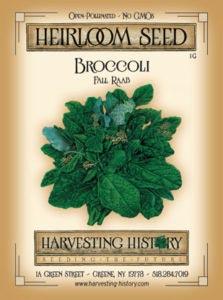
Broccoli requires cool weather and fertile, well-drained garden soil. In the spring, plant as soon as the ground can be worked. Soil should be deeply spaded before planting. Rows should be 18 inches apart. Seed can be planted 1–2 inches deep. When seedlings are 2 inches high, thin them, leaving 12 inches between plants. Adding lime to the soil before planting will sweeten the broccoli.
The absolutely best soil mix for containers is 60% ordinary backyard soil, 20% peat moss, and 20% dehydrated cow manure or, even better, compost. If you do not want to use backyard soil, purchase topsoil (not potting soil, special soil mixes, or premium soil).
Broccoli grown in containers can be started at least two weeks earlier than garden-grown broccoli. The heads of the heading broccoli will be 1–2 inches in diameter smaller, and the plants will be 6–8 inches shorter. Broccoli planted in containers in the spring will produce flowers much sooner, so the heads need to be watched carefully.
In the fall, if you are going to grow broccoli from seed, whether in a container or in the ground, you need to get it planted by July 31 in Zones 5–7 and by October 1 in Zones 8–10.
This is where the “14-Day Rule” really becomes important. Remember, because the daylight hours are getting shorter in the fall (as opposed to getting longer in the spring), in general, it
takes about 14 days longer for a plant to mature in the fall.
DeCicco, because it matures in 55 days in the spring, will take 69 days in the fall. DeCicco, planted from seed on July 1, will mature around September 15.
Calabrese, which is the most popular garden broccoli, takes 80 days when planted in the spring and 94 days when planted in the fall, so it can be grown in the fall, but Calabrese planted from seed on July 1 will not mature until around October 1.
One of the many great things about growing fall broccoli is that the heads and sprouts don’t go to blossoms as
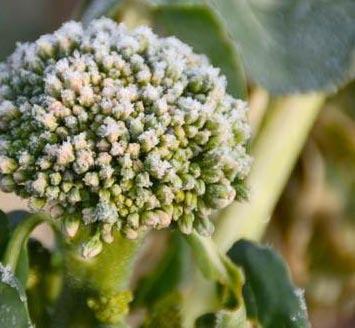
quickly as they do in the spring.
Broccoli is an incredibly nutritious, lowcalorie vegetable. It is high in antioxidants and fiber. This vegetable provides 91% of the daily requirement for Vitamin C, 77% of the daily requirement for Vitamin K, and 15% of the daily requirement for folate.
It is easy to grow and produces over a long growing period. The heading broccolis produce one head, but then continue to produce sprouts for months. Broccoli is incredibly cold-tolerant and will last through numerous light conditions and moderate frosts. The nonheading plants can sometimes tolerate hard frosts.
In a word, broccoli, when compared to other vegetables, is outstanding. o
Barbara Melera is president of Harvesting History (www.harvesting-history.com), a company that sells horticultural and agricultural products, largely of the heirloom variety, along with garden tools and equipment.
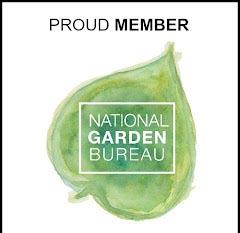
The National Garden Bureau is a nonprofit organization that exists to educate, inspire, and motivate people to increase the use of garden seed, plants, and products in homes, gardens, and workplaces by being the marketing arm of the gardening industry. Our members are experts in the field of horticulture and our information comes directly from these sources. Find out more at https://ngb.org/

By Kathy Jentz
Published by Cool Springs Press
“Groundcover Revolution is must-have book for anyone who is interested in having less lawn, fewer weeds, and reduced mulching. The properties charts will save the reader time and money, the pictures provide inspiration, while the detailed plant portraits give the focused information needed for creating beautiful, functional landscapes.”
―C.L. Fornari, GardenLady.com
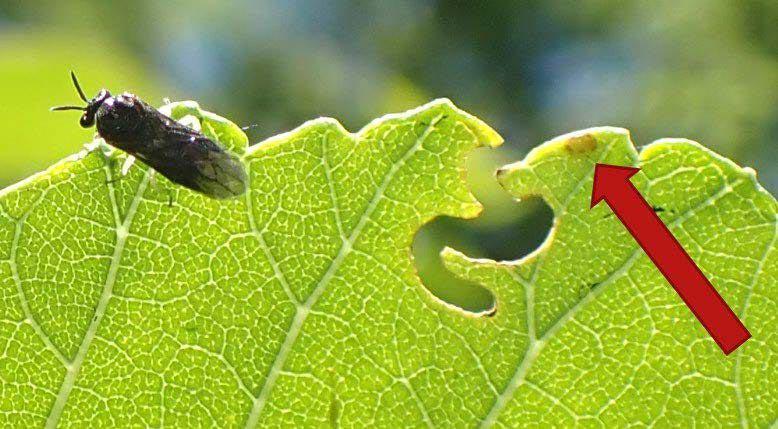
By Carol Allen
The year 2020 saw another non-native forest pest arrive in North America. The Elm Zigzag Sawfly (Aproceros leucopoda Takeuchi) originated in Eastern Asia and was introduced to central Europe in 2003. It is spreading rapidly across Europe and into Great Britain. It was observed in Canada in 2020, then was confirmed in Virginia in 2021. Sightings were recorded in Pennsylvania, North Carolina, Maryland, and New York in 2022. Ohio, Vermont, and Massachusetts saw it in 2023. It was more recently detected in Minnesota in August 2024.
This sawfly feeds exclusively on elm trees (Ulmus spp.), both native and non-native. The early feeding damage, in a characteristic zigzag pattern, is the source of the common name. Later instars eat the entire leaf down to the mid-rib. Healthy trees can usually handle this level of defoliation, but successive years of this loss of leaf or in the presence of Dutch Elm disease or other stress, may result in limb dieback and eventual loss of the tree.
It is dispersing at a rate of 45 to 90 km (28–55 miles) per year. Elm Zigzag Sawfly overwinter as a pupa and the insects emerge in the warm days of spring. Females lay about 60, solitary eggs on the edge of the elm leaves. The larvae emerge within eight days and begin their zigzag feeding migration towards the center of the leaf. Later instars consume the entire leaf. From egg to pupa can take three weeks.
There are some unusual characteris-
tics found in this insect. No male sawflies have been observed. Reproduction is via parthenogenesis; only female adults are produced. Females are capable of laying eggs immediately after emergence from the pupa. No feeding is required.
Two types of cocoons have been observed. A loosely spun, net-like cocoon is produced in the summer months with a hard-shell cocoon being formed for overwintering. A generation can complete its life cycle in less than a month, so multiple generations are possible. Two generations were observed in Virginia in 2021, but only one generation in 2022. Observations in Europe and Russia have seen up to four generations per year.
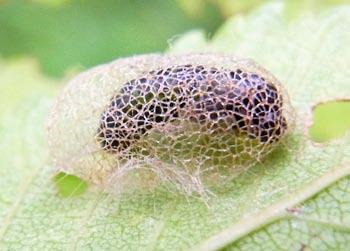
ativecommons.org/licenses/by-sa/3.0>,
The summer cocoon has been observed attached to leaves, but also to other objects such as fence posts. This observation suggests the insect could be distributed through human activity.
The sawfly larvae start out small—1.8
leaf notch, and egg
(red
mm long—and grayish-white. Mature larvae are green with a black band on their head. They have a T-shaped mark above the second and third pair of true legs. Sawfly larvae look like caterpillars, but have six legs attached to their thorax and six or more pairs of fleshy prolegs on their abdomen.
The adults are small, shiny-black winged insects about 7–8 mm long. Their yellow legs are distinguishing.
If you observe the characteristic feeding damage on your elms, hand-remove the larvae and either drown them in a bowl of soapy water or squash them. They are easily controlled by any pesticide that is labeled for use on trees and shrubs. The entomopathogenic fungus, Beauvaria bassiana, was used successfully in Romania. Other European countries applied a variety of chemical controls with success. If you elect to use a pesticide, read and heed the label directions.

Locally in Maryland, they have been observed in both Garrett and Frederick counties, with observations of feeding damage in Baltimore and Ann Arundel Counties. Virginia is recording their presence along the Blue Ridge Mountains and the border with West Virginia. o
Carol Allen describes herself as a committable plant-a-holic. She has more than 25 years’ experience in the horticulture industry, with a special interest in plant pests and diseases; is a Licensed Pesticide Applicator in the state of Maryland; and is an ISACertified Arborist. She can be contacted at carolallen@erols.com.
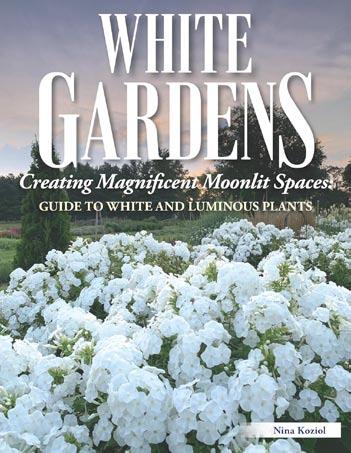
White Gardens: Creating Magnificent Moonlit Spaces: Guide to White and Luminous Plants
Author: Nina Koziol
Publisher: Fox Chapel Publishing List Price: $22.99
Order Links: https://amzn.to/3ZuS5QO and https://bookshop.org/ a/79479/9781580115803
Reviewer: Zachary Intrater
When most people think of gardens, they probably think of vibrant, colorful flowers on a bright, sunny day. This is perfectly reasonable, because there’s tremendous beauty in a rainbow-esque display of red, blue, purple, and pink plants. But as Nina Koziol points out in White Gardens: Creating Magnificent Moonlit Spaces, once the sun starts to set, these vibrant colors can start to fade. And when nighttime comes around, white gardens become the star of the show.
Koziol, a French native, has been a gardening expert for decades, and that expertise shows throughout the book. She opens up with a very practical introduction, explaining the benefits of white gardens, as well as laying out to the reader what to expect in the coming pages. She even uses visual imagery to hook the reader, referencing the “delicate tracery” of branches and the “hint of vanilla or honey fragrance” that may be experienced from certain plants.
The book is split into two parts: “Background & Highlights” and “Selecting the Plants.” In the former section, Koziol touches on the history
of white gardens, also known as evening gardens or moonlight gardens. She says that they have been around for thousands of years and have a rich history all around the globe. She highlights specific examples in countries such as Japan, India, and Wales.
A big chunk of this “Background & Highlights” section is a gallery portion that displays dozens of photos of white gardens, highlighting some beautiful white flowers such as daisies, petunias, Rosa ‘Lykkefund’, and many more. This gallery, while enjoyable to any and all readers, is particularly helpful for newer gardeners who are looking to start their own white gardens and want to see some examples of what it may look like.
Later in the section, Koziol goes into the details and logistics of white gardens. She talks about the different styles that you can choose, how to determine the proper size for your garden, different design elements, and even different lighting techniques. This section is quite comprehensive and shows off Koziol’s expertise in this domain.
In the second part of the book, “Selecting the Plants,” Koziol’s expertise continues to be on display. In this section, she goes over dozens of potential plants that could be included in a white garden, separating them by categories such as annuals, perennials, shrubs, etc. For each plant, she includes vital information such as the size, necessary care and conditions, plant partners, and more. This whole section is another must-read for those looking into starting their own white gardens.
Overall, this book is an excellent guide and resource for potential future white garden owners, or those who already have one and are looking to add to it or just learn more. This book could also just be a fun, informative read for anyone who is interested in gardening, even if they don’t have a white garden. But to those people: Good luck finishing this book and not being tempted to start one. o
Zachary Intrater is a senior in the Philip Merrill College of Journalism at the University of Maryland. This fall semester, he is an intern at Washington Gardener Magazine

The Geriatric Gardener 2.0
Author: Duane Pancoast
Publisher: The Pancoast Concern, Ltd.
Order Link: https://thepancoastconcern.com/the_geriatric_gardener
List Price: $19.99
Reviewer: Beth Py-Lieberman
The golden years! We couldn’t wait for retirement, to the time when we could commit more glorious hours toiling in the garden. But then, there was the knee surgery, the medication that caused balance issues, that bout with skin cancer. And now the garden feels like it is full of hazards.
Fortunately, the 85-year-old gardener extraordinaire, Duane Pancoast is back with still more common-sense advice for those of us who are watching that youthful ease slip away. (His first tip book was published four years ago and reviewed in Washington Gardener in the November 2020 issue.)
Aging, Pancoast wisely points out, is all about adapting to the changes happening in our bodies.
“Old age, and its various euphemisms, tend to have negative connotations. Granted, these are referred to as our golden years but many who are experiencing them…believe that gold is actually pyrite (fool’s gold).” It’s a frustrating disconnect for senior gardeners because our favorite activity is physically demanding.
Book Reviews continued from page 19
Pancoast’s new book is one that might actually tuck nicely into the Christmas stocking of even an energetic young gardener. The reason? His sage tips might save any gardener a few extra steps and provide some longterm safety ideas to ward off the accidental fall.
Adaptive gardening, he says, is to garden smarter, not harder. “Tend your garden, don’t toil in it,” he advises.
Some of his recommendations include making garden paths wider and free of cracks or uneven placement of stone. He offers that soaker hoses and irrigation should replace the heavy lifting of garden hoses. Give up nonessential fertilizing by having soil tested to make sure it has all the right elements. Replace perennials that need to be dug up and divided with attractive shrubs and make sure that the plants you put in are well-suited for the conditions of their location. New tools should be added to your gardening bag: a reacher to avoid having to bend down; a long-handled bulb planter to keep you off your knees; foam sleeves on tools to provide comfort to arthritic fingers; adding some lightweight planters, pots on wheels, and an elevated planter to your container garden
Above all, Pancoast recommends that your senior-age garden have a shady spot where you can sit, rest, and rehydrate. o
Beth Py-Lieberman is the author of the 2023 book The Object at Hand: Intriguing and Inspiring Stories from the Smithsonian Collections. Until her retirement in December, Py-Lieberman served as the senior museums editor at the awardwinning Smithsonian magazine, where over a 37-year-career, she frequented the halls and galleries of the Smithsonian museums, educating readers about their history, art, and science collections, and exhibitions.
Your Ad Here
Contact kathyjentz@gmail.com or call 301.588.6894 for ad rates
The ad deadline is the 10th of each month. Please submit your ad directly to: KathyJentz@gmail.com

Author: Jen McGuinness
Publisher: Cool Springs Press
List Price: $27.99
Order Links: https://amzn.to/3XNRE2L and https://bookshop.org/ a/79479/9780760382110
Reviewer: Marsha Douma
If you want to attract more birds to your garden or invite them to visit your balcony, this is the perfect book to help you do that. The subtitle, “Guidance and Projects for Supporting Birds in Your Landscape,” is an accurate description of the generous instructive offerings in this book.
In the introduction, author Jen McGuinness shares the grim reality of the almost 30% decline, or about 3 billion birds, in the world’s bird population since 1970. The primary cause is loss of habitat, which means birds have fewer places where they can find shelter, food and places to rear their young. This is where we gardeners can come to the rescue.
The author does a wonderful job of explaining the why and how of the interdependence of native plants and the lives of birds. She explains that since plants, insects, and birds evolved together over the millennia, birds came to live where they do, and migrate often thousands of miles, because there were plants that provided shelter, material to build a nest to rear their young, safety from predators, and—of course food in the form of
seeds, fruits (think berries), nectar, and insects. Hummingbirds and monarch butterflies are well known examples of the kind of specialization some birds and insects have come to require to thrive. Darwin’s classic work, On the Origin of the Species, explains in great detail how multiple aspects of a bird’s anatomy and behavior evolved to take advantage of the local food supply and nesting opportunities. Once this changes, the birds may or may not be able to adapt to their changed environment. Evolution usually takes a very long time.
The relevant question for a reader, then, is what to plant to help the birds in their neighborhood, given their own circumstances. This is where the book excels. The greatest value of the book is the comprehensive, easy-to-read charts of available native plants for many different gardening situations that would be the most useful in attracting and supporting birds. There are also lovely photographs of plants and birds throughout the book. Therefore, this book can be read cover to cover to learn more about the entire topic, or used as a reference to efficiently find a list of plants reliably helpful in achieving the goal of attracting more birds for a particular type of garden or landscape.
McGuinness chose to organize the book by “projects,” rather than by plants. Therefore, the same plant will be mentioned for various types of gardens. This is very useful. For example, if all I have is a small balcony, rather than read through all the ways the included plants could be used, I can go directly to the small space section, find the balcony project, and readily find out which plants would be best for me. This makes the relevant plant selections easily and efficiently accessible.
The heart of the book is the 35 individual projects that the author divides among four sections. These larger sections are General, which is birdfriendly information all readers would be interested in, and then Small-Space, Medium-Space, and Large-Space areas. Each project has its own charts that list the names of plants appropriate for the type of garden, the size the plant will ultimately become, its water
and light needs, which season that plant is particularly interesting in and useful to the birds, its native range, and the particular birds that will be attracted to these plants.
In the “small-space projects” section, she addresses the plants that would be useful in shady patios; various size containers, including window boxes for homes, apartments and condos, plus small outdoor areas that are often the forgotten parts of a garden, such as along walkways, the driveway, and in the front of a house where the plants need to be able to thrive with minimum care.
Her next section is the many varieties of plants useful in various “mediumspace projects.” In this section, she further breaks down the type of plants according to gardener interest and garden realities. The topics individually discussed are gardens with moisturerich soil, a garden to attract the insects the birds need to survive, the plants preferred by hummingbirds and songbirds, deer-resistant gardens, plus the value of flowering vines as a hideaway in any garden where there is room.
Her final section is for “large-space projects.” Here she includes the plants useful in a woodland setting; plants to attract owls, warblers, and migrating birds; as well as birds that prefer the mountains, the edges of streams, and along the oceans and bays.
I enthusiastically recommend this book to all bird lovers who want to attract them to where they live. Also to all gardeners who want to not only have plants in their garden that are beautiful, but ones that can support more birds at the same time. o
Marsha Douma is a retired dentist and lifelong gardener who also enjoys swimming, tennis, and playing the piano. She lives in Rockville, MD.
The book reviews in this issue are by volunteer members of the Washington Gardener Reader Panel. To join the Washington Gardener Volunteer Reader Panel, send an email with your name and address to: KathyJentz@gmail.com We look forward to having you be a vital part of our local gardening publication. o
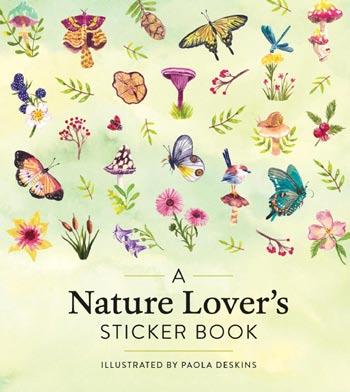
Note: These book reviews include links to Amazon.com and BookShop.org for ordering them. Washington Gardener Magazine might receive a few cents from each order placed after you click on these links.
A Nature Lover’s Sticker Book
Illustrator: Paola Deskins
Publisher: Workman Publishing List Price: $15.00
Order Links: https://amzn.to/3zdwEcj and https://bookshop.org/ a/79479/9781523524808
Reviewer: Kathy Jentz
This is a collection of 800+ illustrated stickers—from mushrooms to cacti to wild animals, along with flowers and plants. It is a charming little volume that would make the perfect gift for the nature lover in your life.
The stickers are generally small—most are less than 1 inch high and wide. This makes them useful for placing in the margins of a garden or travel journal, or to decorate a gift package
Kathy Jentz is the founder and editor of Washington Gardener

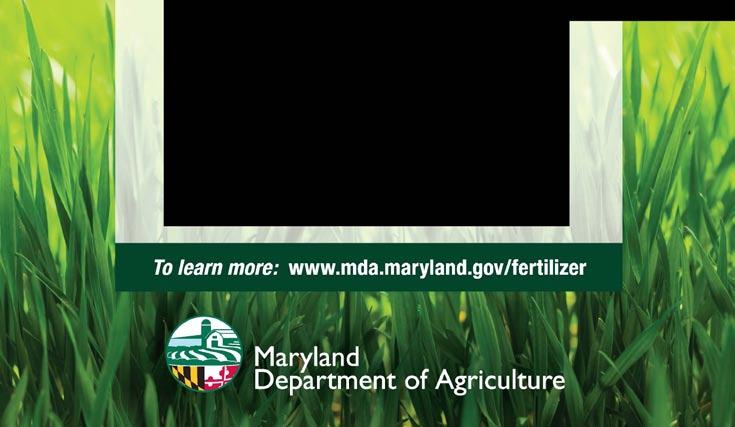

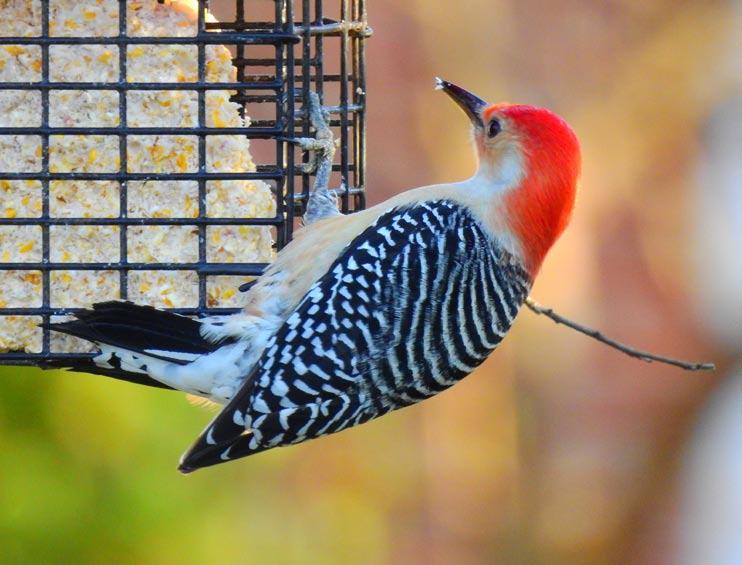
By Cecily Nabors
Looking at this guy chowing down on your suet-feeder, you might ask, “Where is the red belly? And why isn’t it called a Red-headed Woodpecker?” Admittedly, the reddish flush on the lower belly feathers is inconspicuous and rarely visible, but there’s another woodpecker whose whole head is covered with a red hood, so that one wins the “redheaded” title.
A better name for our Red-bellied Woodpeckers (Melanerpes carolinus) might be “red-capped.” They have black-and-white barring on their backs and tail feathers, set off by a red ribbon on their heads. The males’ red cap glistens from nape over the crown to the beak; the females have red napes and gray crowns and foreheads.
Red-bellieds are primarily birds of the southeastern United States. They have been expanding to the north and are now common throughout the eastern United States. They stay with us all year. Like all woodpeckers, these birds are agile explorers of tree trunks. Their feet have two toes going forward and two going back, giving them great control. They hitch along, leaning back onto their stiff tail feathers as they search for goodies. Their long, sticky tongues are perfect for extracting prey from bark and crevices. In fact, the tongues are so long that they wind up inside their heads when they’re retracted.
Red-bellied Woodpeckers eat insects like beetles, ants, and larvae, plus fruit and grain. They have been observed caching acorns, beechnuts, and other seeds. They may wedge large nuts into bark crevices, then whack them into manageable pieces using their strong beaks.
These vocal woodpeckers have a musical call—churr, churr—or a higherpitched kwirr, kwirr. Their notes ring through the woodlands, especially in early winter, when mates are sought. They do use their big beaks to drum to advertise themselves, but they don’t seem as inclined to drum on human structures as flickers notoriously are. Red-bellied males intersperse short bursts of drumming with their rolling calls. The message is: “Ladies, I’m handsome, musical, and irresistible!”

Red-bellieds nest in cavities, usually excavating a new one every year. They are partial to dead trees or the long stob of a dead branch or trunk. Often, a new cavity is dug below the previous one, creating an apartment-house effect.
Old woodpecker holes are also desirable dwellings for bluebirds, wrens, chickadees, and other cavity-nesters. Unfortunately, starlings also seek cavities for nesting. They will often evict the smaller birds, and even fight the woodpeckers for possession.
A male red-bellied starts the cavity and taps softly to advertise it. When a female accepts, she taps a gentle percussive duet with the male, then helps complete the foot-deep nest cavity and add a wood-chip lining. Both parents incubate the eggs, usually four or five, and care for the young.
Whacking acorns, drilling for bugs, excavating a nest cavity: How do woodpeckers’ heads withstand all that banging? The birds evolved with multiple coping capabilities, from large neck muscles that distribute the forces, to spongy bones in their heads that protect the brain.
Red-bellied Woodpeckers are active at bird-feeders. These big birds are not aggressive, often peacefully sharing feeders with other birds. Bossy Blue Jays, however, love to play cock of the walk and drive away any competition, including woodpeckers, at a feeder. The “pecking order” is unclear, as the jay sometimes yields to the red-bellied’s big, dagger-like bill.
Though woodpeckers may poke holes in fruit or steal some berries, they more than pay their way in a garden or yard by scarfing up the insects and larvae that would damage food or flowers. To attract these birds, provide feeders filled with suet, peanuts, and blackoil sunflower seeds. Dead trees may encourage the birds to forage naturally or even nest in your yard, and they may feed on berry trees such as hawthorn or mountain-ash in fall or winter. The cheerful, noisy Red-bellied Woodpecker is a treat any time of year. o
Cecily Nabors is a retired software manager who has been watching birds for much of her life. She publishes the Good-Natured Observations blog at cecilynabors.com.


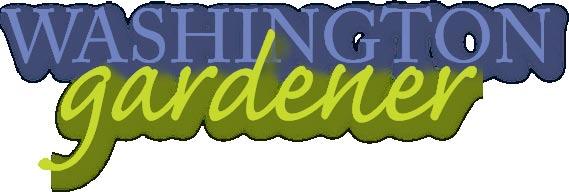
YOU CAN REQUEST A SINGLE COPY OF PRINT BACK ISSUES FOR $6 EACH OR ANY 6 BACK ISSUES FOR $24, OR ALL 40+ PRINT BACK ISSUES FOR JUST $100. PRICE INCLUDES POSTAGE AND HANDLING. PLEASE SPECIFY THE ISSUE DATE(S). ORDER MUST BE PREPAID BY CHECK OR MONEY ORDER. SEND ORDERS TO: WASHINGTON GARDENER, 826 PHILADELPHIA AVE., SILVER SPRING, MD 20910
MARCH/APRIL 2005
• Landscape DIY vs. Pro
• Prevent Gardener’s Back
• Ladew Topiary Gardens
• Cherry Trees
MAY/JUNE 2005
• Stunning Plant Combinations
• Turning Clay into Rich Soil
• Wild Garlic
• Strawberries
JULY/AUGUST 2005
• Water Gardens
• Poison Ivy
• Disguising a Sloping Yard
• Kenilworth Aquatic Gardens
SEPTEMBER/OCTOBER 2005
• Container Gardens
• Clematis Vines
• Sponge Gardening/Rain Gardens
• 5 Insect Enemies of Gardeners
NOVEMBER/DECEMBER 2005
• Backyard Bird Habitats
• Hellebores
• Building a Coldframe
• Bulb Planting Basics
JANUARY/FEBRUARY 2006
• Garden Decor Principles
• Primroses
• Tasty Heirloom Veggies
• U.S. Botanic Garden
MARCH/APRIL 2006
• Top 10 Small Trees and Large Shrubs
• Azaleas
• Figs, Berries, & Persimmons
• Basic Pruning Principles
MAY/JUNE 2006
• Using Native Plants in Your Landscape
• Crabgrass
• Peppers
• Secret Sources for Free Plants
JULY/AUGUST 2006
• Hydrangeas
• Theme Gardens
• Agave
• Find Garden Space by Growing Up
SEPTEMBER/OCTOBER 2006
• Shade Gardening
• Hosta Care Guide
• Fig-growing Tips and Recipes
NOVEMBER/DECEMBER 2006
• Horticultural Careers
• Juniper Care Guide
• Winter Squash Growing Tips and Recipes
• Layer/Lasagna Gardening
JANUARY/FEBRUARY 2007
• Indoor Gardening
• Daphne Care Guide
• Asparagus Growing Tips and Recipes
• Houseplant Propagation
MARCH/APRIL 2007
• Stormwater Management
• Dogwood Selection & Care Guide
• Early Spring Vegetable Growing Tips
• Franciscan Monastery Bulb Gardens
MAY/JUNE 2007
• Roses: Easy Care Tips
• Native Roses & Heirloom Roses
• Edible Flowers
• How to Plant a Bare-root Rose
JULY/AUGUST 2007
• Groundcovers: Alternatives to Turfgrass
• How to Pinch, Prune, & Dead-head
• William Paca House & Gardens
• Hardy Geraniums
SEPTEMBER/OCTOBER 2007
• Succulents: Hardy to our Region
• Drought-Tolerant Natives
• Southern Vegetables
• Seed Saving Savvy Tips
NOVEMBER/DECEMBER 2007
• Gardening with Children
• Indoor Bulb-Forcing Basics
• National Museum of the American Indian
• Versatile Viburnums
JANUARY/FEBRUARY 2008
• Dealing with Deer
• Our Favorite Garden Tools
• Delightful Daffodils
MARCH/APRIL 2008
• Patio, Balcony, Rooftop Container Gardens
• Our Favorite Garden Tools
• Coral Bells (Heuchera)
MAY/JUNE 2008
• Growing Great Tomatoes
• Glamorous Gladiolus
• Seed-Starting Basics
SUMMER 2009
• Grow Grapes in the Mid- Atlantic
• Passionflowers
• Mulching Basics
• Growing Hops
FALL 2009
• Apples
• How to Save Tomato Seeds
• Persimmons
WINTER 2009
• Battling Garden Thugs
• How to Start Seeds Indoors
• Red Twig Dogwoods
• Unusual Edibles to Grow in Our Region
SPRING 2010
• Community Gardens
• Building a Raised Bed
• Dwar f Iris
• Broccoli
SUMMER 2010
• Fragrance Gardens
• Watering Without Waste
• Lavender
• Potatoes
FALL 2010
• Vines and Climbers
• Battling Stink Bugs
• Russian Sage
• Garlic
WINTER 2010
• Paths and Walkways
• Edgeworthia
• Kohlrabi
you trying to reach thousands of gardeners in the greater DC region/MidAtlantic area? Washington Gardener Magazine goes out in the middle of every month. Contact kathyjentz@gmail.com or call 301.588.6894 for ad rates (starting from $200). The ad deadline is the 5th of each month. Please submit your ad directly to: kathyjentz@gmail.com
Got a gardening question you need answered? Send your questions to KathyJentz@gmail. com and use the subject line “Q&A.”
Please also include your first name, last initial, and what city and state you are writing from. Then look for your answered questions in upcoming issues.
SPRING 2011
• Cutting-Edge Gardens
• Final Frost Dates and When to Plant
• Bleeding Hearts
• Onions
• Flavorful Fruiting Natives
JULY/AUGUST 2008
• Landscaping with Ornamental Grasses
• Edible Grasses to Graze On
• Slug and Snail Control
• Sage Advice: Sun-Loving Salvias
SEPTEMBER/OCTOBER 2008
• Autumn Edibles — What to Plant Now
• Beguiling Barrenworts (Epimediums)
• Best Time to Plant Spring-blooming Bulbs
• 14 Dry Shade Plants Too Good to Overlook
NOVEMBER/DECEMBER 2008
• Outdoor Lighting Essentials
• How to Prune Fruiting Trees, Shrubs, Vines
• 5 Top Tips for Overwintering Tender Bulbs
• Harry Lauder’s Walking Stick
JANUARY/FEBRUARY 2009
• Compost Happens: Nature’s Free Fertilizer
• Managing Stormwater with a Rain Garden
• Visiting Virginia’s State Arboretum
• Grow Winter Hazel for Winter Color
MARCH/APRIL 2009
SUMMER 2011
• Ornamental Edibles
• Urban Foraging
• Amsonia/Arkansas Blue Star
• Growing Corn in the Mid-Atlantic
FALL 2011
• Herb Gardens
• Toad Lilies
• Sweet Potatoes
• Cool Weather Cover Crops
WINTER 2011/EARLY SPRING 2012
• Green Roofs and Walls
• Heaths and Heathers
• Radishes
SPRING 2012
• Pollinator Gardens
• Brunnera: Perennial of the Year
• Growing Yacon
SUMMER 2012
• Tropical Gardens
• Captivating Canna
• Icebox Watermelons
SPRING 2013
• Great Garden Soil
• All About Asters
• 40+ Free and Low-cost Local Garden Tips
• Spring Edibles Planting Guide
• Testing Your Soil for a Fresh Start
• Redbud Tree Selection and Care
SOLDOUT!SOLDOUT!SOLDOUT!
• Squash Vine Borer
SUMMER/FALL 2013
• Miniature/Faerie Gardens
• Beguiling Abelias
• Best Viewing Spots for Virginia Bluebells
MAY/JUNE 2009
• Top Easy Summer Annuals for DC Heat
• Salad Table Project
• Grow and Enjoy Eggplant
• How to Chuck a Woodchuck
• Growing Great Carrots
WINTER/EARLY SPRING 2014
• Ferns for the Mid-Atlantic
• Chanticleer Gardens
• Beet Growing Basics
Antique Botanical Prints for the decorator, collector, connoisseur, and art lover.
Jentz Prints can be purchased most weekends (weather-dependent) at the world-famous Eastern Market.
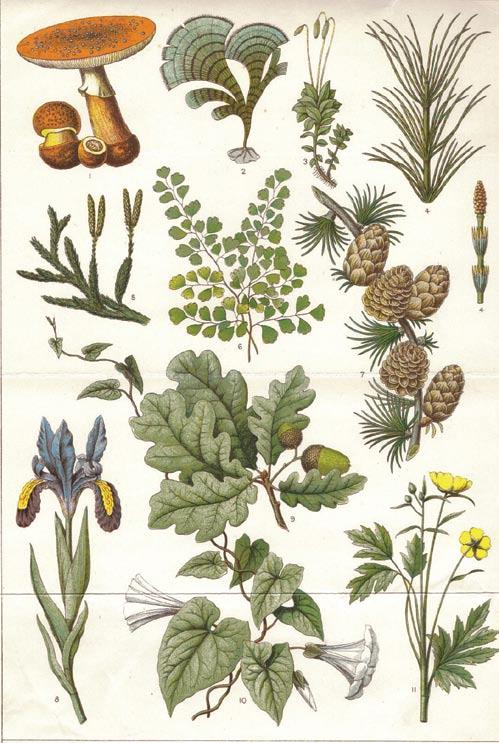
Antique prints are affordable—most in the $10-$30 range—and they are the perfect gift idea for that plant lover in your life. And don’t forget to buy a few for yourself!
For more information or to get a detailed show schedule, please contact Jentz Prints by email at UllrichJ@aol.com.